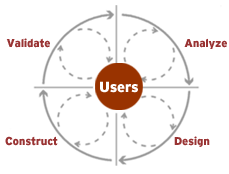“A leading architect once built a cluster of office buildings set in a central green. The landscape crew asked him where he wanted the sidewalks between the buildings. His reply: ‘Just plant grass between the buildings.’ By late summer the new lawn was laced with pathways of trodden grass. The paths followed the most efficient line between the points of connection, turned in easy curves rather than at right angles and were sized according to traffic flow. In the fall the architect simply paved in the pathways. Not only did the paths have a design beauty, but they responded directly to user needs.”
– Christopher Williams, “Origins of Form” (1995)
Designing Websites and applications is a complex process and should be a team effort. It begins with a multi-disciplinary group of skills that includes a user interface designer and usability engineer. A strong focus on designing for users and with users needs to be central to the team’s philosophy. Dr. Mandel works with companies as the expert interface design and usability member of the design and development team.
Dr. Mandel designs application and site interfaces by following these user-oriented approaches:
- Define user perspectives, user demographics and user requirements
- Determine user tasks, scenarios and workflows
- Prototype conceptual designs
- Conduct user reviews of conceptual designs
- Create interface and navigation prototypes
- Conduct user usability evaluations of interface/navigation prototypes
- Develop graphical and functional design prototypes
Methodology: The iterative design and development cycle

Theo Mandel promotes an iterative interface design process that involves users and focuses on prototyping and testing designs from early stages through final product development.
The four iterative stages include analyze, design, construct, and validate. This diagram (from Dr. Mandel’s book, The Elements of User Interface Design) highlights how users are central to interface design and usability. Users should be designed for and with, not designed to.
